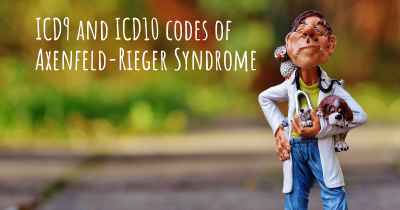What is the history of Axenfeld-Rieger Syndrome?
When was Axenfeld-Rieger Syndrome discovered? What is the story of this discovery? Was it coincidence or not?

Axenfeld-Rieger Syndrome (ARS) is a rare genetic disorder that affects the development of the eyes, teeth, and other parts of the body. It was first described by two ophthalmologists, Theodor Axenfeld and Hans Rieger, in the early 20th century. Their groundbreaking work paved the way for further research and understanding of this complex syndrome.
Theodor Axenfeld, a German ophthalmologist, was born in 1867. He made significant contributions to the field of ophthalmology and is best known for his work on congenital eye abnormalities. In 1920, Axenfeld published a paper describing a group of patients with a distinct set of eye abnormalities, which later became known as Axenfeld Syndrome. This syndrome was characterized by anterior segment dysgenesis, a condition where the front part of the eye fails to develop properly.
Hans Rieger, a Swiss ophthalmologist, was born in 1901. He also made notable contributions to the field of ophthalmology and is particularly known for his work on glaucoma. In 1935, Rieger published a paper describing a syndrome that shared similarities with Axenfeld Syndrome but also involved dental abnormalities. This syndrome was later named Rieger Syndrome.
Over time, it became evident that Axenfeld Syndrome and Rieger Syndrome were closely related and likely represented different manifestations of the same underlying condition. In 1954, the term "Axenfeld-Rieger Syndrome" was coined to encompass both syndromes and acknowledge the contributions of both Axenfeld and Rieger.
Axenfeld-Rieger Syndrome is a rare autosomal dominant disorder, meaning that a person only needs to inherit the gene mutation from one parent to develop the syndrome. The exact prevalence of ARS is unknown, but it is estimated to affect approximately 1 in 200,000 individuals.
ARS is characterized by a wide range of symptoms that primarily affect the eyes, teeth, and facial structure. The most common eye abnormalities include anterior segment dysgenesis, which can lead to glaucoma, iris abnormalities, and corneal defects. Dental abnormalities often involve the development of fewer teeth than normal, as well as abnormalities in tooth shape and structure. Additionally, individuals with ARS may have distinctive facial features, such as a flattened mid-face, a prominent forehead, and a broad nasal bridge.
Genetic studies have identified several genes associated with ARS, including PITX2, FOXC1, and PAX6. These genes play crucial roles in the development of various tissues and organs, including the eyes and teeth. Mutations in these genes disrupt normal development, leading to the characteristic features of ARS.
Research into the molecular mechanisms underlying ARS has provided valuable insights into the development of the eyes and teeth. Scientists have used animal models and cell culture studies to investigate how gene mutations affect these developmental processes. These studies have helped unravel the complex interactions between different genes and signaling pathways involved in eye and tooth development.
While there is currently no cure for Axenfeld-Rieger Syndrome, treatment focuses on managing the symptoms and preventing complications. Regular eye examinations are essential to monitor and manage glaucoma, which is a common complication of ARS. Dental care is also crucial to address any abnormalities and ensure proper oral health.
In conclusion, Axenfeld-Rieger Syndrome is a rare genetic disorder that was first described by Theodor Axenfeld and Hans Rieger in the early 20th century. Their pioneering work laid the foundation for further research into this complex syndrome. ARS is characterized by a range of eye, dental, and facial abnormalities, and is caused by mutations in genes involved in development. Ongoing research continues to deepen our understanding of the underlying mechanisms and may eventually lead to improved treatments for individuals with ARS.








